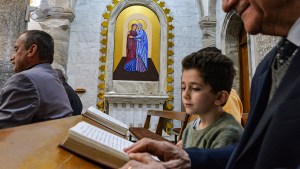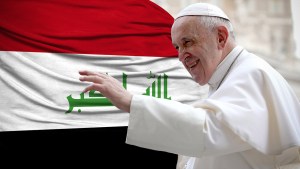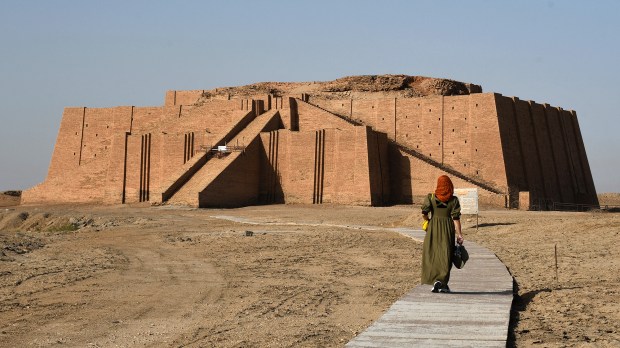In many ways, Pope Francis’ visit to Iraq is a pilgrimage to part of “the Holy Land.” It is a land that was graced by the presence of Abraham, the Old Testament prophets Daniel and Jonah, and apostles who personally knew Jesus.
The visit, the first one to be undertaken by a pope of Rome, is the “fulfillment of the promise that Pope St. John Paul II wanted to walk in the year 2000 in the footsteps of faith beginning with our father Abraham who came from the Ur of the Chaldeans,” said Bishop Francis Kalabat, the bishop of the Chaldean Catholic Eparchy of Mar Thomas in Detroit. “Our Christian faith, especially being the custodians of Ur and the children of Abraham, makes this dream come true.”
“Iraq will always be special,” Bishop Kalabat said in an email to Aleteia, “not just because our parents immigrated from there, but because the faith began there.”
When Pope Francis steps off the plane Friday afternoon, he will set foot on ground with a long and complex history. Some believe that the Garden of Eden was located in this land, as well as the Tower of Babel. The Hanging Gardens, one of the Seven Wonders of the Ancient World, awed visitors to Babylon, thought to be just south of present-day Baghdad, on the banks of the Euphrates River. Exiled Israelites who lived in this region included the prophet Daniel, who was rescued from the lion’s den here, as Catholic News Service pointed out.
Baghdad itself was founded in A.D. 762 by the Abbasid Caliph al-Mansur near the Tigris and Euphrates rivers.
Though Iraq is more than 98% Muslim, there is still a significant Christian presence, dating to the early decades of the Church.
“I can show you the grave of my great great great grandmother,” Ano Jawhar Abdoka, Minister of Transportation and Communication for the Kurdistan Regional Government, said in an interview. “In the year 90, we had a bishop in Erbil. This is one of the oldest Christian communities in the world. They became Christian by the preaching of St. Thomas, one of the Twelve Apostles, and Mar Addai, and Mar Mari, two of the 72 Disciples. Having the pope visit us gives us a boost to remain in our homeland.”
The Christian community in Iraq today consists of Chaldeans, Syriacs, Armenians, Latins, Melkites, Orthodox and Protestants.
Itinerary
After visiting the presidential palace in Baghdad on Friday, March 5, Pope Francis will move over to the Syrian Catholic Cathedral of Sayidat al-Nejat (Our Lady of Salvation), where he will address bishops, priests, consecrated religious, seminarians and catechists. One of the largest churches in the city, the cathedral was the site of two terrorist attacks, including the October 31, 2010, Islamic State group attack that killed two priests and 46 lay people. The church was designed by a Polish architect to look like a boat, like the one that carried Jesus and his Apostles during a storm.
On Saturday, March 6, Pope Francis will travel to the south of Iraq and take part in an interreligious gathering in Ur. This is the birthplace of Abraham. It was here that Abraham spoke for the first time with God (Genesis 11: 28-31). The Lord asked Abraham to leave his homeland and go to the land of Canaan.
Dating back some six millennia and founded upon a course of the Euphrates River, Ur of the Chaldees is one of the oldest and most important Sumerian cities. It was the capital of the Sumerian Empire, which at the end of the 3rd millennium BC ruled over all of Mesopotamia. The very advantageous position, between the Tigris and Euphrates, near the Persian Gulf, facilitated the city’s development, commercial and political dominance, transforming it into one of the most prosperous and powerful cities in the region. It experienced great expansion with the First Dynasty (2500- 2300 BC) and the Third Dynasty (2000-1900 BC), of which temples, tombs and palaces remain. Under Ur-Nammu, founder of the Third dynasty, the majestic stepped tower known as a ziggurat was built. It was dedicated to Nannar, the Sumerian god of the Moon, and can still be visited.
Later on Saturday, the Holy Father will celebrate a Mass in the Chaldean Rite at the Cathedral of St. Joseph in Baghdad, assisted by Cardinal Louis Raphaël Sako, the Patriarch of Babylon of the Chaldeans, who is based in Baghdad. Built in the 1950s, the cathedral was consecrated by Chaldean Patriarch Yusef VII Ghanima in 1956 and can accommodate more than 400 persons.
Christian refuge
Sunday, March 7, will be the most interesting day of the papal visit for those who have followed the plight of Christians in Iraq over the past six or seven years. The Holy Father will fly to Erbil, the capital and largest city of the autonomous region of Iraqi Kurdistan, but then be transported to nearby Mosul. This city, on the banks of the western Tigris, is the administrative capital of the Governorate of Nineveh. Near here is the archaeological dig of the ancient Assyrian city of Nineveh, which dates back to 6000 BC.
Over the course of 2,500 years, Mosul has represented the pluralistic identity of Iraq, thanks to the coexistence of various ethnic, linguistic and religious groups. Founded in the 7th century BC, as part of the Assyrian Empire, Mosul was an important trading center in the Abbasid era, due to its strategic position. It reached the apex of its influence in the 12th century AD, under the Zangid dynasty. It was then that the metalworking and painting schools were established in Mosul, which in the 13th century gave way to a thriving craft industry and continued for centuries. During the reigns of the Mongol and Turkish dynasties, as well as in the early Ottoman period, Mosul was further improved with the construction of numerous mosques and madrassas. The “city of the prophets,” named for the presence of the tombs of five Muslim prophets, also known as Um Al-Rabi’ain, “the mother of the two springs,” has maintained its medieval architecture and its original nucleus over time, with Islamic, Christian, and Ottoman buildings, and an extraordinary mix of ethnicities and religions, until it was occupied for three years by troops of the Islamic State group, between June 2014 and July 2017.
It is estimated that about half a million people, including over 120,000 Christians, fled Mosul, which in 2004 had 1,846,500 inhabitants. The city was subjected to systematic devastation including the destruction of numerous churches, the mausoleum of the prophet Jonah, and a section of the Nineveh archaeological site, as well as that of very rare manuscripts and more than 100,000 books kept in the Mosul Library, archaeological finds and numerous statues present in the collections of the Nineveh Museum.
In June 2017 the Islamic State, surrounded by government forces, and with control of only the old city, destroyed the mosque of Mūr ad-dīn, a symbol of the Caliphate, which, however, a few days later was reconquered by the Iraqi army along with part of the medieval area of the city. In July 2017, after nine months of fighting, Mosul was liberated.
Today, reconstruction is being undertaken to allow the return of refugees. Last November the Archaeological Museum, which houses what remains of the heritage of ancient Nineveh, reopened to the public, though damaged by looting. In recent months, UNESCO has started the restoration work of the Al-Nuri Mosque and two churches in the old part of the city: the Dominican church of al-Saa’a, “Our Lady of the Hour,” whose bell tower and clock were a gift from the Empress Eugenia, wife of Napoleon III, and the Syrian-Catholic Cathedral of al-Tahera.
The pope, along with Archbishop Najeeb Michaeel, O.P, Archbishop of Mosul of the Chaldeans, will pray at the Hosh al-Bieaa, a church square, for the victims of the war. He then will take a helicopter to Qaraqosh, also known as Bakhdida, Baghdeda or Al Hamdaniya, an Assyrian city in northern Iraq.
Qaraqosh is near the ruins of the ancient Assyrian cities Nimrud and Nineveh. In the summer of 2014, militiamen of the Islamic State invaded, destroying the homes of Christians and their churches, the library and other important buildings. Ninety percent of the 50,000 inhabitants were Christian, but they quickly fled to Iraqi Kurdistan. The town was freed from the jihadist occupation two years later, and since then, Christian charitable organizations and international associations have been trying to reconstruct what was destroyed, such as the largest Christian church of the country, at Tahira al-Kubra, the Cathedral of the Immaculate Conception. This assistance has allowed about 46% of those who lived in the town before the invasion to return.
The Cathedral of the Immaculate Conception of Qaraqosh was built between 1932 and 1948 thanks to the donations and hard work of the farmers of the Nineveh Plain, southeast of Mosul. Also known as Al-Tahira Cathedral, it is the largest church in Iraq. Rectangular in plan, the building can accommodate over 2,500 people. The church has three naves and 22 massive marble columns. In August of 2014, the cathedral was vandalized, desecrated and burned by the Islamic State. After the liberation of the city in October 2016, the building returned to use as a sacred place, and an improvised altar and a large wooden cross on the roof were set up. However its real reconstruction began in January 2020. A new statue of Mary was erected on the restored bell tower, the soot-blackened marble walls and columns cleaned up, and a two-meter-high image of Our Lady of the Immaculate Conception was placed on the altar.
Pope Francis will lead the Angelus Prayer and give an address in the church.
Open-air Mass
From here, the pope will return to Erbil for the last ceremony of his visit, an evening Mass in the Franso Hariri Stadium in Erbil, which normally holds about 28,000 spectators. Due to COVID-19 restrictions, however, far fewer will be admitted. Earlier in the day, the pope will have lunch at the Patriarchal Seminary of St. Peter, located in the Ankawa section of Erbil. It is the only seminary operating in Iraq, and it is where Chaldean priests are trained for the country and the diaspora. From 1960 the seminary had operated in Baghdad, but in 2007, following the kidnapping of the rector and vice-rector, it was moved to Ankawa.
Erbil is considered one of the oldest cities of the world, with its first settlement going back at least to the 23rd century BC. Sumerians, Assyrians, Babylonians, Sassanids, Medes, Romans, Abbasids and Ottomans lived in the ancient heart of the city, in its Citadel, located on a 30-meter high plateau. The Citadel, declared a World Heritage Site by UNESCO in 2014, includes the Great Mosque and the Kurdish Textile Museum, which in turn houses the Museum of Civilization and the Syriac Heritage Museum.
The city has welcomed about 540,000 internally displaced persons into its refugee camps from the rest of the country, mainly from Qaraqosh and Mosul, to escape the Islamic State.
Ankawa is a section of Erbil where most of the Christians live. “It is now the biggest Christian city in the Middle East,” said Abdoka, the Minister of Transportation and Communication, who is a Chaldean Catholic. “It’s a center for approximately 65,000 Christians.”
After the 2003 U.S.-led invasion of Iraq, many Christians began to flee, because they were considered to be on the side of the Americans and other Europeans in the coalition. Many fled to Kurdistan. “Now 80-90% of Christians in Iraq are living in the Kurdistan region,” Abdoka said.

Read more:
5 things to know about the Christians of Iraq

Read more:
We can’t disappoint the Iraqi people a 2nd time, says Pope Francis

